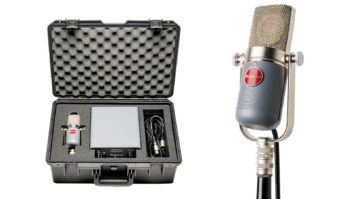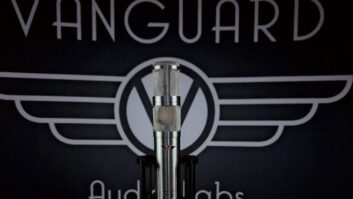I recently discovered the CM67se tube condenser mic from Advanced Audio, a Canadian microphone company. I know the first question most people will ask. “Does it sound like a Neumann U67? It says ‘67’ right in the name.” Well, here’s the honest truth: I don’t know and I don’t care. When I put up a microphone in front of a singer or an instrument, I don’t do it because of what other mic it might sound like. I only care about what it sounds like on this singer or instrument on this song. In my experience, this mic sounds very good on many singers and it’s also very affordable ($965 direct, including shipping).
Features
The CM67se is a multi-pattern (omni, cardioid, figure 8) condenser microphone that uses an AK67 capsule (35mm outside diameter, center-fed, dual backplate, 6 micron diaphragms) with pad and high-pass filter switches on the mic. It’s a large microphone at over nine inches long, has a tapered body, a trapezoidal head basket and a Electro-Harmonix 6072a tube. It comes with a shock-mount, power supply, vinyl pouch and aluminum travel case. It is manufactured in China to AA’s specs and, according to owner Dave Thomas, it was not designed as an exact clone of the U67, but there are definite similarities.
In Use
I used the CM67se while recording several albums and that provided me the opportunity to try it out next to other mics that I typically use. On one orchestral session at Ocean Way B in Nashville, I put the CM67se on harp and it sounded fabulous: full and clean with a bright top end that didn’t get “pingy.” On the next orchestra session (in the same room two weeks later), I chose to use the Sony C-800G on harp, an application where it excels. This was the same player on the same instrument in the same room, the only difference being the mic. During the session I honestly wished I had the CM67se on the harp instead of the Sony, to my surprise. I would have swapped it but I had decided to use the CM67se on a cello group instead (one mic per player), right beside another pair of vintage U67s. I purposely didn’t ask the second engineer which was which; during the session, I solo’d through the tracks and didn’t notice a difference in the sound of any one mic.
I also tried it on acoustic guitar, instead of my typical Neumann KM 84, lined up to the left of the sound hole, about eight inches out. I used it for an entire day and on several different guitars. I paired it with an Audio-Technica AT4050 on the body, both running through API 512 preamps. I was very pleased with the sound, which was full and clear.
The only place I tried the CM67se and didn’t care for it was electric guitar. I was not surprised, as I rarely use condensers for that purpose.
Vocals, however, is the place where the CM67se shined the brightest. I put it up beside one of my favorite vocal mics: my custom Soundelux (now Bock Audio) ELUX 251. Both were running through a Millennia Media HV-3R preamp. On this project, I had several different lead vocalists to record, male and female. I tried each of them singing on both mics. The decision was evenly split between the AA and Soundelux/Bock. (I did another project two weeks later with four more vocalists and, that time, used the AA CM47.) The ELUX 251 is fuller on the bottom and more natural sounding on top — smoother, if you will. The CM67se is brighter on top and leaner on the bottom. The contrast on each singer made it immediately apparent which mic best represented their voice.
For this review, I’ve provided 24-bit/48 kHz samples of the CM67se in use, as described above. Clips include male voices, female voices, male/female duet and harp sound sources. These are available at http://www.3daudioinc.com/par/cm67samples.
Summary
I have used several Advanced Audio mics since I first met Mr. Thomas years ago, and I’ve never been disappointed. I also own two of his tube CM47 mics—a very similar transducer which sounds great on saxophone, male voice and French horns—and a CM12—a nice, bright mic for female singers. I literally use them all the time and they are valuable assets in my mic collection. In the interest of full disclosure, Advanced Audio advertises on 3dB, my recording forum.
Price: $965 direct
Contact: Advanced Audio | http://www.aamicrophones.com







